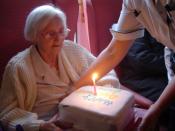My studies dealt with the relationship of early home health nursing intervention, child abuse and positive parenting skills. All of the studies shared the purpose of looking at early intervention and attempting to show a positive correlation in early home nursing intervention and positive health related behaviors, positive perinatal outcomes, and social competence.
All of the studies had an independent variable of increasing the face to face contact time in the home by the public health nurse. They all also shared the common hypothesis that child abuse would decrease and positive parenting would increase from this increased home visitation time. Settings varied among the studies; 1 in California, 1 in a New York community, 1 in a large metropolitan area, and one in Newark, New Jersey. The first study analyzed 144 adolescents; they were then stratified and randomized using key variables. The control group received routine pre and post partum aftercare and one the experimental group received up to 17 home care visits.
In 6 of the 7 instruments used in this study, validity and reliability were not addressed. Nurse interviews and a test that was videotaped were validated by 4 nurses with expertise in research. The validity on that test was well established, as was the reliability. The internal consistency was 0.83 and Cronbach?s alpha was 0.80 on that test which was a videotaped Nursing Child Assessment Satellite Training. Medical records were also used in this study. That study showed a relationship between intensive home care and improved outcomes but was not significant enough to prove the hypothesis.
In the second study involved another at risk group but at risk because of their drug abuse instead of young age. This group was of 60 drug abusing women and their instruments showed more consistent validity and reliability testing was still not well documented. This study depended on a lot of self-reporting by the participants and again showed positive effects but not significant.
The third study was somewhat of a study within a study. Originally 400 participants were involved in a study and this is a byproduct of that study. 56 of the participants were extracted to complete the question: ?In families where maltreatment is known will home health care visits decrease the incidence of child abuse.? In this study it appears that the hypothesis was supported but by what cause is still up for grabs. The question is raised in the results that did these parents take better care of their children because they had intensive home care contact or were the problems just caught sooner because there was a home care nurse intervening. Further studies were suggested. Study #4 did not split the participants into separate groups but rather did pre and post intervention testing. 2 of the 3 instruments used were not well documented for validity and reliability but the third one was construct validity tested, test-retest reliabilities between 0.75 and 0.91 and internal consistency reliability tested with a Cronbach?s alpha of 0.93. In this study adolescents were placed on a level 1 when admitted to the program and assigned a mentor which meant intensive home care of visits 1 time per week by a nursing paraprofessional supervised by a nurse. As issues resolved themselves and the participants had less crisis? they would move up a level and have less intensive involvement until they reached level IV and that would be virtual independence but with the understanding they could ask for help if needed. The specific hypothesis being tested in this study were; #1 Decrease percentage of low birthweight infants to less than 13.5%. #2 Percentage of infant mortality to be less than 1.5%. #3 Experience a decrease in scores for potential child abuse. #4 Obtain a percentage of age appropriate immunized infants higher than 62%. They supported 3 of the 4 hypothesis. The third hypothesis was not supported based on the fact that the questionnaire was too long and the participants did not want to complete it. The common limitation in these studies was the many dependent variables made it difficult to pick out the true causal effects. There were also many variables that were totally out of anyone?s control such as alcohol use, other people living in the homes, self reporting of information instead of objective tests for things such as drug use.
I learned a tremendous amount about research, the lack of studies done by nurses, the inconsistent way in which repeat studies are conducted, not enough validation of earlier studies. I was surprised by the inability of the studies to prove the hypothesis that intensive home care would have an overwhelmingly positive response by parents. I was encouraged that there is some evidence that could support these hypotheses but more studies are needed to justify the extra money that would be spent by intensifying home health to these populations. By the way only one study even mentioned the amount of money it costs to have increased home care, it was $1655,00 per child per year.





